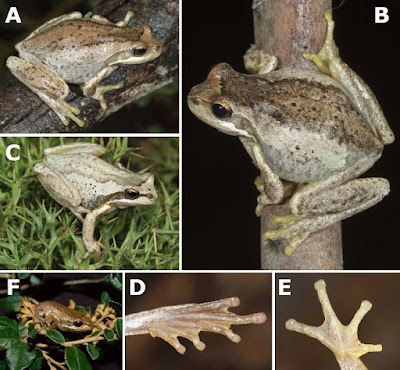 |
| Litoria sibilus Parkin, Rowley, Elliott-Tate, Mahony, Sumner, Melville & Donnellan, 2024 |
Abstract
The brown tree frog (Litoria ewingii) is a relatively widespread, commonly encountered pelodryadid frog from south-eastern Australia, known for its characteristic whistling call. The distribution of Litoria ewingii spans over more than 350,000 km2, encompassing a range of moist temperate habitats, and is fragmented by well-known biogeographic barriers. A preliminary analysis of mitochondrial DNA sequences revealed evidence for deep phylogenetic structure between some of these fragmented populations. In this study, we sought to re-evaluate the systematics and taxonomy of Litoria ewingii sensu lato by analysing variation in nuclear and mitochondrial DNA, adult morphology and male advertisement calls throughout the species’ range. Our analyses reveal two additional, deeply divergent and allopatric lineages in South Australia. We herein re-describe Litoria ewingii from Tasmania, southern New South Wales, Victoria and south-eastern South Australia, resurrect the name Litoria calliscelis for a species occurring in the Mount Lofty Ranges and Fleurieu Peninsula in South Australia, and describe a new species, Litoria sibilus sp. nov., endemic to Kangaroo Island.
Key words: mtDNA, single-nucleotide polymorphisms, biogeography, Kangaroo Island, Murray River Basin
Litoria sibilus sp. nov.
Suggested common name: Kangaroo Island Tree Frog
Diagnosis. Litoria sibilus is diagnosable from all other members of the L. ewingii group by a combination of (1) adult body size 25–34 mm for males and 28–43 mm for females, (2) moderately robust build, (3) pads wider than fingers (mean Fin3W/Fin3DW = 0.6) and toes (mean Toe4W/Toe4DW = 0.7), (4) webbing on hands vestigial but relatively well-developed on the feet (extending to the 1st subarticular tubercle on the 4th toe [see Fig 8, Type B]), (5) posterior edge of thigh orange-pink, usually patterned with dark spots and blotches (n= 26/27), occasionally plain (n=1/27), (6) dark spots or blotches in inguinal region usually absent (n=23/27), sometimes a single spot may be present right at the junction of the thigh and body (n=4/27), (7) genetically by apomorphic nucleotide states at 15 sites in the ND4 gene. Diagnoses of Litoria sibilus and the other species described herein are presented in Table 8 for ease of comparison.
Etymology. The specific epithet, sibilus, is a masculine Latin 2nd declension noun meaning whistle or hiss. It is used in apposition to the genus name.
Tom Parkin, Jodi J. L. Rowley, Jessica Elliott-Tate, Michael J. Mahony, Joanna Sumner, Jane Melville and Steve C. Donnellan. 2024. Systematic Assessment of the Brown Tree Frog (Anura: Pelodryadidae: Litoria ewingii) reveals Two endemic Species in South Australia. Zootaxa. 5406(1); 1-36. DOI: 10.11646/zootaxa.5406.1.1

